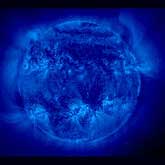Ultraviolet Light
 Ultraviolet light is a form of radiation which is not visible to the human eye. It's in an invisible part of the 'electromagnetic spectrum'. Radiated energy, or radiation, is given off by many objects: a light bulb, a crackling fire, and stars are some examples of objects which emit radiation. The type of radiation being emitted depends on the temperature of the object. A coal glowing red in a barbecue is cooler than our Sun, which appears yellow, which is cooler still than some stars which appear bright white.
Ultraviolet light is a form of radiation which is not visible to the human eye. It's in an invisible part of the 'electromagnetic spectrum'. Radiated energy, or radiation, is given off by many objects: a light bulb, a crackling fire, and stars are some examples of objects which emit radiation. The type of radiation being emitted depends on the temperature of the object. A coal glowing red in a barbecue is cooler than our Sun, which appears yellow, which is cooler still than some stars which appear bright white.
If a prism is used to break-up the radiated light from an object into it's component colors, the 'visible light' which our eyes can see makes up only a small part of the total spectrum. Visible light runs from the familiar blue to green to yellow to orange to red. Red light is the least energetic of the colors of visible light, and blue is the most energetic. Beyond the red end of the visible part of the spectrum lies the infrared and radio radiation. Infrared 'light' is familiar to us as heat, while radio waves are used for TV and radio broadcasts.
Beyond the blue end of the visible spectrum lies ultraviolet light, X-rays and gamma-rays. All of the X-rays, gamma-rays and ultraviolet light emitted by stars are absorbed by the Earth's atmosphere. That is why we need to send our telescopes into space (such as Astro-2 !) in order to measure the ultraviolet light from stars and galaxies. Many scientists are interested in studying the invisible universe of ultraviolet light, since the hottest and most active objects in the universe give off large amounts of ultraviolet energy.
About the Author
NASA Marshall Space Flight Center
 The George C. Marshall Space Flight Center, located in Huntsville, Alabama, is the U.S. government's civilian rocketry and spacecraft propulsion research center. As the largest NASA center, MSFC's first mission was developing the Saturn launch vehicles for the Apollo program.
The George C. Marshall Space Flight Center, located in Huntsville, Alabama, is the U.S. government's civilian rocketry and spacecraft propulsion research center. As the largest NASA center, MSFC's first mission was developing the Saturn launch vehicles for the Apollo program.


